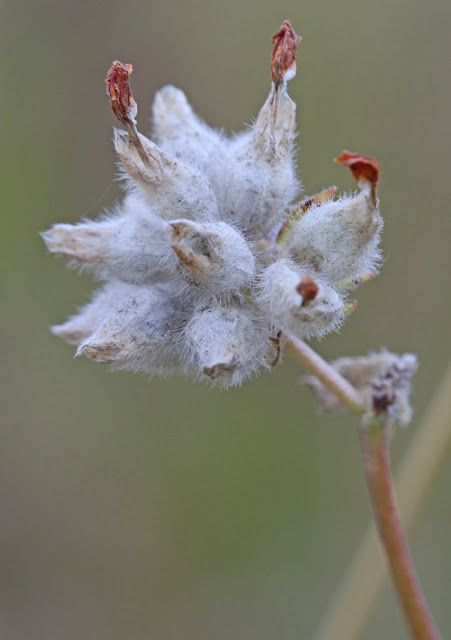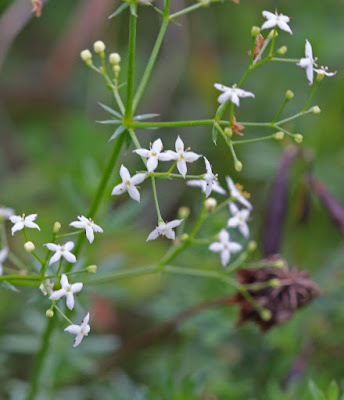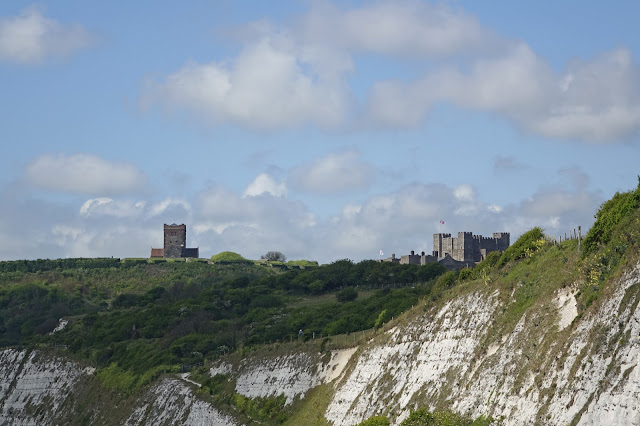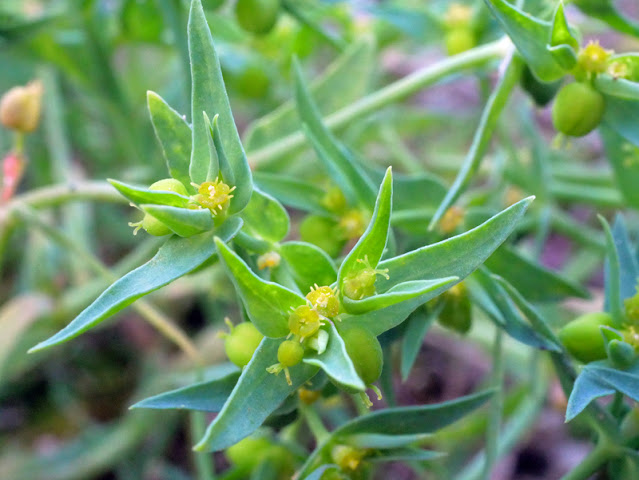Arable and Ruderal Revisited, Longfield, Kent - 07/08/17
The arable area is locally called The Gallops and may soon be lost to intensive farming, such is life. The ruderal area could be described as a chalk grassland area that no-one seems to own and public access it freely. It's likely to be built on within the next decade as locals think it's waste ground.
As such, I took a couple of hours this day to photograph and record the species I saw for posterity. As usual, I'll post them alphabetically (scientific name) for my ease of writing!
A not too brilliant photo of Thyme-leaved Sandwort, but they are tiny flowers.
Arenaria serpyllifolia
subsp serpyllifolia
A surprise find of a saltmarsh plant by the (salted in Winter) roadside.
Grass-leaved Orache
Atriplex littoralis
Right:
Lucerne, the flowers are always a shade of blue; the seeds are coiled several times.
Medicago sativa subsp sativa
Below:
Sand Lucerne, can be a multitude of flower colours, sometimes metallic too! Seeds are only coiled 1 to 1.5 times.
Medicago sativa subsp varia
You have to get flat on the ground to photograph these up close, though in shady woodlands I have seen them grow up to 2' tall.
Often found in lawns, this is Selfheal
Prunella vulgaris
As such, I took a couple of hours this day to photograph and record the species I saw for posterity. As usual, I'll post them alphabetically (scientific name) for my ease of writing!
Kidney Vetch, seeds and flowers.
Anthyllis vulneraria
A not too brilliant photo of Thyme-leaved Sandwort, but they are tiny flowers.
Arenaria serpyllifolia
subsp serpyllifolia
The nicely scented Mugwort. Rub a leaf then smell your fingers, beautiful! The flowers lack petals, so they don't look impressive, though the plants often grow to 4' tall.
Artemisia vulgaris
A surprise find of a saltmarsh plant by the (salted in Winter) roadside.
Grass-leaved Orache
Atriplex littoralis
The next plant always brightens up a sunny day with its pink flowers. In coastal areas they can be tiny, but inland can be over a foot tall with many flowers atop branched stems. They close up on cloudy days and at night.
Common Centaury
Centaurium erythraea
Centaurium erythraea
This tiny plant is on the Kent RPR and it's declining. It's a lovely little flower whose leaves smell like Basil and Thyme combined. I guess that's why it's called Basil Thyme then!
Clinopodium acinos
Another plant on the Kent RPR is this Crosswort which is in seed. In Spring it has whorls of tiny yellow flowers all about the stem and looks great. It often grows in dense stands, amplifying the effect of millions of its tiny flowers together.
Cruciata laevipes
The next 3 photos are of a small native called Blue Fleabane. There's no part of it that is blue, so I wonder how it got its name originally. It has pink or lilac rays and a yellow centre and it's still flowering now in many places (September).
Erigeron acris
Eyebrights are a plant group that I doubt I'll ever get to grips with unless I wear x50 magnifying glasses! Even with a hand lens I can't really make out the identifying features I need to see.
As such, this is simply: Euphrasia agg
It seems Hedge Bedstraw has come back into flower in several places now.
Galium album
There were still a few Perforate St. John's wort in flower.
Hypericum perforatum
The rather dull but nice florets of Ploughman's Spikenard, a tall plant with many flower heads like this on top of a single branched stem.
Inula conyzae
I kept finding new botanical records here, such is the nature of recording at different times of the year to previous recorders. Here's a new record, escaped from nearby gardens.
Broad-leaved Everlasting Pea
Lathyrus latifolius
There were several Dandelion like plants in flower. These can be a pain as they all look rather similar. However, the easiest way to learn them is to take an ID book out with you and look at the different flower parts to ID it. Works for me I hope!
Rough Hawkbit
Leontodon hispidus
Common Toadflax is a delightful plant and is a common arable plant. It's even found in street pavements and sown itself into my back garden.
Linaria vulgaris
Viewed from above, I think I'm being "mooned" at!
Right:
Lucerne, the flowers are always a shade of blue; the seeds are coiled several times.
Medicago sativa subsp sativa
Below:
Sand Lucerne, can be a multitude of flower colours, sometimes metallic too! Seeds are only coiled 1 to 1.5 times.
Medicago sativa subsp varia
Sainfoin is another fodder crop relict of cultivation in this arable field. It grows tall and puts on an impressive display earlier in the year. It's seeds are rather weird, like giant aphids, so I've included a photo of those as well.
Onobrychis viciifolia
On the chalk turf were hundreds of Wild Marjoram in flower, always a delight to see and smell. The latter being very similar to Oregano that you buy dried in little jars.
The yellow flower photobombing is Wild Mignonette (Reseda lutea)
Origanum vulgare
The Common Poppy, a beloved wildflower with many associations which are no doubt familiar to you.
I've yet to find any other type of poppy here, but I keep looking.
Papaver rhoeas
The flower head of a very common plant right now, Hawkweed Oxtongue. It has strap like hairy leaves and is very rough to the touch.
Picris hieracioides
Of course, Knotgrass is just about everywhere, in fields, gardens, paths, streets and so on. Generally it's not worth the effort to work out which one you're looking at, so they are called:
Polygonum aviculare agg.
But that wasn't all! I found a Kent RPR species of Knotgrass that looks different and is easy to identify due to the very thin leaves, deep pink buds and nutlets poking out of the sepals. I had found this on the Gallops last year, but re-found it this time in a completely different area and monad.
Cornfield Knotgrass
Polygonum rurivagum
You have to get flat on the ground to photograph these up close, though in shady woodlands I have seen them grow up to 2' tall.
Often found in lawns, this is Selfheal
Prunella vulgaris
This tiny flower belongs to Field Madder, usually lilac in colour though they can be white. When stressed, the leaves can also turn bright red.
Sherardia arvensis
Of course, when walking arable field edges, there's sure to be some of these. Really pretty, but often very small, Field Pansy.
Viola arvensis
There were of course, many many more wildflowers there, including thousands of Scentless Mayweeds, several Ragworts, and much more.
I hope these places aren't developed, but I've learned that my hopes in relation to nature and wildlife rarely hold good. Profits usually win out in the end.
I'll leave you with 2 wildlife shots from the same trip
along came a spider.....
Take care
Dave
@Barbus59














































Comments
Post a Comment
Comments welcome from those interested in my articles. For spammers don't bother as I moderate all comments prior to posting them.